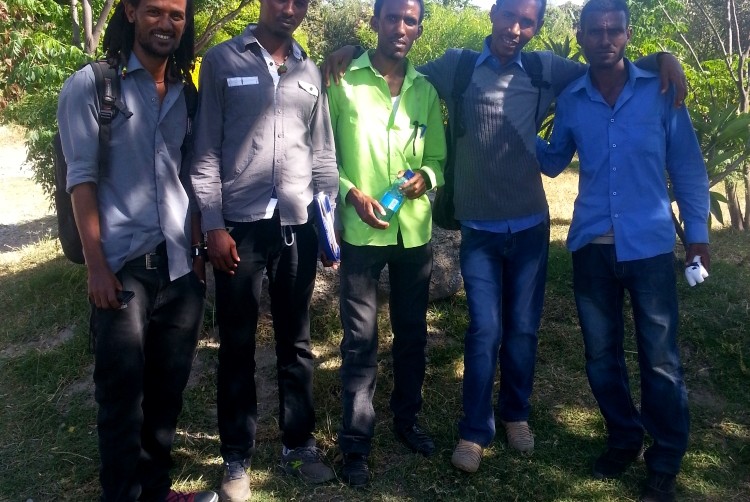By Katie Mcevinney
“I see VetAfrica as one of the best performing applications for human and animal health problems”
Cojengo worked with Addis Ababa Vet College in Ethiopia to help empower students and staff to make better decisions about livestock disease through the use of VetAfrica Mobile.
We spoke to Project Manager Tariku about his overall experience and plans for future projects as well as three VetAfrica users – Matewos, Lalisa and Mitiku - who were involved in implementing VetAfrica in the field.
So, Tariku, when did you start working with Cojengo?
Tariku: I started to work with Craig Taylor - CEO of Cojengo - in mid 2012 before the company was officially established.
And as project manager, what were your hopes and expectations for VetAfrica?
Tariku: My expectation was the development of a locally customised application, dealing with the problem of animal disease diagnosis in Africa.
Who else was involved in the trials in the field?
Tariku: The study involved final year undergraduate veterinary medicine students who acted as data/case collectors and laboratory technicians from Addis Ababa Vet College.
Matewos, as one of the students involved with the project, what were your expectations of VetAfrica?
Matewos: I hoped that the project would succeed and be an important method of disease diagnosis in veterinary medicine. Not only this, but I also hoped it would lead in the development of disease diagnosis techniques in veterinary medicine.
And what did you think the benefits of using VetAfrica compared to any current methods available were?
Matewos: In terms of ease of use, it is not difficult to use and it does not require a high knowledge level except the ability to interpret observed clinical signs into English medical words. And in terms of efficiency, the application is not time consuming. Using the application takes a matter of five minutes work once the animal is observed correctly.
Mitiku: This application could really help us reduce drug resistance, as well as save time for diagnosis.
Tariku, what were the challenges facing customers before VetAfrica, for example, misdiagnosis in livestock?
Tariku: Misdiagnosis is one of the bottlenecks for treating animal diseases especially for those who cannot refer to books and find diagnostic labs.
What were the challenges facing students like yourselves, and veterinary clinicians that supervised you during your field placements?
Matewos: Almost all of the diseases included in the application are seasonal diseases that commonly occur during and shortly after rainfall. But the time we were assigned to do the research was a dry period, which negatively affects regular occurrence of the diseases.
Mitiku: And there are also diseases that are difficult to diagnosis without laboratories.
Were there any particular features that really worked/didn’t work when implemented?
Tariku: The particular feature of forming a cloud server of cases which can be stored for long time, finding lists of important disease worked well.
How would you rate the quality of the VetAfrica service? And the quality of the technology, for example, was it easy to use?
Tariku: Despite the fact that I haven’t worked with similar companies before, I found VetAfrica of high quality and technology compared to others like use of SMS to report diseases to central areas. VetAfrica is super-easy to use.
Matewos: The quality of the technology varies across different smartphones. Therefore if such problems are resolved, the application will be high in quality and become the only option of disease diagnosis particularly in developing countries.
Lalisa: VetAfrica gives high quality service once it starts but it does need sufficient network.
How do you think VetAfrica could be improved upon to make it more effective?
Tariku: VetAfrica could be improved by using inputs from end users once it is dispatched. Having ambassadors in each country for better lobbying is also important.
Matewos: Animal history is also crucial in the diagnosis of diseases but there was no space left to register the history of the animal unlike the clinical signs on VetAfrica. If the animal history is not available in the diagnostic procedure of livestock diseases, then there will be high probability of faulty diagnosis since many diseases are interrelated. Therefore, it is very important.
Do you plan to work with Cojengo in any additional projects in the future?
Tariku: Sure, I would like to involve in future project identification, proposal preparation, and evaluation of apps in field condition.
Matewos: Yes, I will be very happy to work with project if the chance available.
Anything you would like to add?
Tariku: I would advise Cojengo to network more, have more representatives and look for markets in several countries.
Matewos: I feel happy for my participation in the project. I hope the project will succeed if the problems are resolved.
This experience has proven to be vital in the development of VetAfrica, with Cojengo using the feedback to improve and build on the effectiveness and usability of the application.

